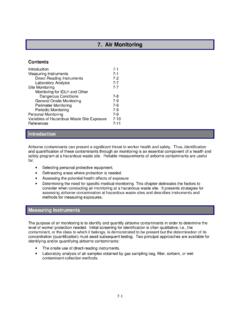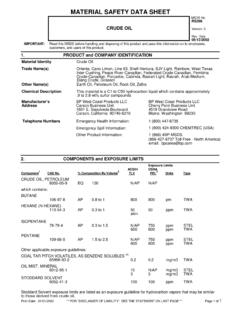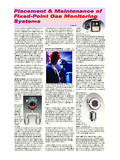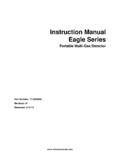Transcription of Safety Policy - Gartner Refrigeration
1 Safety Policy Table of Contents Safety Policy 1. A Workplace Accident and Injury Reduction Program (AWAIR) .. 2. 2. Safety First Priority .. 2. Individual Cooperation 2. Responsible Safety Person .. 3. Goals and Objects .. 3. Safety and Health Responsibilities .. 3. All Employees .. 3. Safety Director Responsibilities .. 3. Project Manager/Superintendent/Foreman/Superviso r Responsibilities .. 3. Office Manager/Clerk Responsibilities .. 4. Subcontractors Responsibilities .. 4. Hazard Identification and Control .. 4. Hazard Identification Overview .. 4. Work Site Analysis .. 5. Standard Operating Procedures (SOP) .. 5. Workplace Hazard Analysis and Control .. 5. Safety 5. Environmental Monitoring .. 5. Communication .. 6. Accident Investigation .. 6. Safety Committee .. 6. Enforcement of Safety Policies .. 6.
2 Safety Rules .. 7. Refrigeration Systems Safe Practices .. 9. Anhydrous Ammonia (NH3) .. 9. Safe Practices: .. 9. First 10. Return to Work/Light Duty Program .. 12. First Report of Injury .. 12. Return to Work .. 12. Electrical Safety .. 13. Definitions .. 13. Safe Working Practices .. 13. Ground Fault Circuit Interrupters (GFCI) .. 15. Assured Equipment Grounding Conductor 15. Testing .. 15. Electrical Safety Rules .. 16. Training .. 16. Unqualified Person .. 16. Retraining .. 16. Certification .. 16. Lock Out/Tag Out Program (LO/TO) .. 18. Definitions .. 18. Lock 19. TagOut .. 19. Inspection .. 19. Equipment .. 19. For Construction .. 19. For Service .. 19. Emergency Lock Out/Tag Out Removal .. 20. Sequence of Lock Out/Tag Out .. 20. Restoring Equipment to Service .. 21. Group Lock Out/Tag Out Procedure.
3 21. Shift or Personnel 21. Special Procedures .. 21. Long Term Lock Out/Tag Out .. 22. Training .. 22. Retraining .. 22. Certification .. 22. Equipment/Task Specific LOTO Procedures .. 23. Reciprocating and/or Screw Compressors .. 23. Evaporator Coils .. 23. Liquid Ammonia 24. Evaporative Condenser .. 24. Water Pumps .. 24. Electric Control/Solenoid Valves .. 24. Electric Control/Solenoid Valves .. 24. Fall Protection .. 26. Definitions .. 26. Conventional Fall Protection .. 27. Guardrail 27. Personal Fall Arrest Systems (Full-Body Harness and Lanyards) .. 27. Alternative Fall 27. Warning Line Systems .. 27. Fall Protection Plans .. 28. Roof Openings and Towboards .. 28. Training .. 29. Specific Training .. 29. Retraining .. 29. Certification .. 29. Sample Fall Protection Program .. 30. Changes to Plan.
4 32. Enforcement .. 32. Accident Investigations .. 32. Hazard Communication/Right-to-Know .. 33. Hazard Communication .. 33. General Information .. 33. Container 33. Material Safety Data Sheets .. 33. List of Hazardous Chemicals .. 34. Hazardous Non-Routine 34. Contractor and Adjacent Trade Notification .. 34. Employee Information and Training .. 34. 35. Emergency/First Aid Procedures .. 36. Site Evacuation .. 36. Fire .. 36. Property Damage/ Collapse .. 36. Severe Weather .. 37. Hazardous Materials Release .. 37. Emergency Services / First Aid (Optional) .. 37. Eye-Washing 38. Ammonia Safety .. 38. Ammonia First Aid Procedures .. 38. Emergency Measures .. 39. Personal Protective Equipment .. 43. Eye Protection .. 43. Hand Protection .. 43. Body Protection .. 43. Head 44. Hearing Protection .. 44. Respiratory Protection.
5 45. Training .. 45. Retraining .. 45. Confined Space Program .. 49. Definitions .. 49. Confined Space Entry Identification .. 50. Types of Confined Spaces .. 50. Construction .. 50. General Industry .. 51. Rescue 51. Entry (Work)Permit System .. 51. Entry Preparation .. 52. Operating Procedures .. 53. Training .. 53. Certification .. 54. Entry Preparation .. 58. Respirator Protection Program .. 62. Respirator Protection .. 62. Scope and Application .. 62. Ammonia Safety Guidelines .. 63. MSA KWICK DRAW PUMP .. 63. Responsibilities .. 64. Medical .. 65. Fit Testing .. 66. Selection Procedure .. 66. Respirator Use .. 67. Breathing 68. Respirator Malfunction .. 68. Maintenance .. 69. SCBA Air Tanks .. 70. Training .. 72. Hot Work Program .. 73. 73. Fire Prevention and Protection .. 73. Employee Protection.
6 73. Training .. 74. Hot Work Permits Procedure .. 75. Hot Work Operations .. 75. 75. Source of Ignition .. 75. Initiating a Hot Work Permit .. 75. Issuing a Hot Work Permit .. 76. Performing Hot Work .. 76. Completing the Hot Work Permit Procedure .. 77. Personnel Responsibilities .. 78. Originator .. 78. Site Maintenance Supervisor/Customer .. 78. Cutter/Welder .. 78. Fire Watch .. 78. Employee Training Plan .. 82. Asbestos Policy .. 83. Standard Operating Procedures .. 84. SOP - Charging Ammonia Into System .. 84. SOP - Cut-In Procedure Ammonia Tie-In .. 87. SOP - Ammonia Removal .. 91. SOP - Ammonia 92. SOP - Ammonia/Oil/Solvent Disposal .. 94. SOP - CFC/HCFC Safety .. 95. Company Disciplinary Policy .. 97. Notification of Written Warning for Violation Company Disciplinary Policy .. 99. Scaffold Program.
7 100. General Requirements .. 100. Platform Construction .. 100. Component Mixing .. 101. Supported Scaffolds .. 101. Access .. 102. Access for Erecting and Dismantling Scaffolds .. 102. Use .. 102. Fall Protection .. 103. Falling Object Protection .. 103. Specific Scaffold 103. Fabricated Frame 103. Mobile Scaffolds .. 104. Suspended 104. Training .. 104. Retraining .. 105. Certification .. 105. Bloodborne Pathogens Exposure Control .. 106. Universal Precautions .. 106. Fire Protection and Prevention .. 108. Fire Prevention Regulations .. 108. General Safety .. 108. Extinguisher Selection and Distribution .. 109. Fire Types .. 109. Fire Extinguishers .. 109. Classifications .. 109. Extinguisher Suitability .. 111. Water - Air-Pressurized Water Extinguishers (APW).. 112. CO2 or Dry Chemical Carbon Dioxide Extinguishers.
8 113. Multi-Purpose Dry Chemical Extinguishers .. 113. How to Choose a Fire Extinguisher .. 115. What Each Type of Fire Extinguisher Looks Like .. 115. Flammable and Combustible Liquids Storage .. 116. Indoor Storage .. 116. Outdoor Storage .. 116. Fire Control .. 116. Dispensing Liquids .. 117. Training .. 117. Hand and Portable Power Tools .. 118. Scope .. 118. General Safety Precautions .. 118. Hand Tools .. 118. Power Tools .. 119. Potential 119. Guards .. 119. Safety Switches .. 119. Electric Tool .. 119. Safety Precautions .. 120. Pneumatic Tools .. 120. Liquid Fuel-Powered Tools .. 120. Powered Abrasive Wheel 121. Ladders and Stairways .. 122. Scope .. 122. Training Requirements .. 122. Ladders .. 122. Construction Requirements .. 122. Safety Guidelines .. 122. Stepladders .. 123. Portable Ladders.
9 123. Extension Ladders .. 123. Storing and Care of Ladders .. 124. Stairways .. 124. Safety Guidelines .. 125. Process Safety Management Contractor Responsibilities .. 126. 126. General .. 126. Specific Requirements .. 126. Training .. 127. Safe Work Practices .. 128. Hot Work .. 128. Incident Investigations .. 128. Trade Secrets .. 128. Subcontractor Management Plan .. 129. General Requirements .. 129. Rigging Safety .. 131. 131. Scope .. 131. References .. 131. General .. 131. Definitions .. 131. Procedure .. 131. Rigging Practices .. 131. Additional requirements of synthetic slings;.. 133. Requirements of plate clamps: .. 133. Signal Person .. 133. Rigging Crew .. 134. Inspection .. 134. Critical Lifts .. 135. Critical Lifts shall include .. 135. RECORDS RETENTION .. 135. Powered Industrial Trucks,Forklifts, Aerial Lifts, Scissor 136.
10 Scope .. 136. Definitions .. 136. Training .. 136. Safety Regulations for Operators .. 137. Inspection Guidelines .. 138. Safety Regulations for Personnel Platforms .. 138. Equipment Inspections .. 138. SOP - Hazardous Material Spill Prevention & Response 140. Spill 140. General Requirements .. 140. Spill Containment .. 140. Emergency Procedures .. 140. Plan Management .. 141. Training .. 141. Spill 141. Facility Inspections .. 142. Spill Reporting .. 142. Accidents .. 143. Traffic 143. Accident Investigation Program .. 145. 145. Policy .. 145. Responsibilities .. 145. Safety Director/Project Management .. 145. Supervisors .. 146. Employees .. 146. Hazard 146. Engineering Controls .. 146. Administrative 146. Training Controls .. 146. Supervisor 146. Immediate 147. Accident Prevention .. 147. Initial Investigation Procedures.







